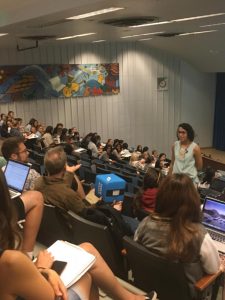As part of the large TLEF project, “Enhancing Secondary Teacher Candidates’ Digital Competencies”, coordinated by ETS and Yvonne Dawydiak, Technology Integration Mentor, students and instructors in each section of ESPE 317 had the opportunity to partake in lectures and workshops that modeled digital technology integration and centered on the importance of assistive technologies and open education resources. We would like to thank Kathy Heikkila, course coordinator of the Development and Exceptionality course along with the seminar instructors for their interest and support in helping us introduce teacher candidates (TC’s) to these important concepts and resources.

Catchbox microphone in action with BEd teacher candidates
The first workshop incorporated the concept of Universal Design for Learning (UDL) and focused on the integration of assistive technologies in the classroom to provide a more equal and just learning environment for all learners. In the assistive technologies lecture, we discussed and introduced the various resources available to teachers to use with varied learners in the classroom based on five types of assistive technologies: reading, vision, writing, communicating and studying. TC’s participated in open discussions surrounding the five categories of assistive technologies, reflected on their practicum experiences and had hands on opportunities to play with different digital technologies including ThinkMap Visual Thesaurus and ShowMe Interactive Whiteboard.
The second set of workshops was composed of two parts (lecture and seminar) and was a joint effort between CTLT and the UBC library. This initiative was designed to introduce TC’s to licensing and open education resources (OER) and, hopefully, to promote the sharing of materials online among educators.
At the beginning of the lecture, teacher candidates were asked to participate in an online poll and reflect on their own experiences in collecting and developing resources. Although responses showed that the majority of teacher candidates access and use online resources when developing lesson plans and activities, responses also showed that teacher candidates did not typically share their own works online. They argued that they were unaware of how to license their work and where to share them.
With this in mind, we introduced TC’s to Creative Commons, which is a non-profit organization that allows individuals to license their works in order to share them freely online as OER. During the lecture TC’s also had the opportunity to explore some examples of OER on three well-known open education repositories: Teach BC, OER Commons and Share my lesson. The following week, teacher candidates participated in a seminar, which gave them the opportunity to work on their lesson plans and reflect on different ways in which their work can be licensed and shared on an open education repository. Teacher candidates enjoyed the hands on activities arguing that it clarified various questions they had regarding licensing, the use of images in their works and selection of open education repositories. Although feedback was positive, teacher candidates expressed concern regarding the quality of their lesson plans and their confidence in sharing their work.
We found teacher candidates and their instructors to be receptive to the integration of technology in the classroom and the concept of OER. Teacher candidates were enthused to reflect on their practicum experience and discuss their own integration of technology and how they share their works. In addition, teacher candidates expressed interest in learning more about the technological resources available and suggested that UBC continue to conduct these workshops for future BEd students.

